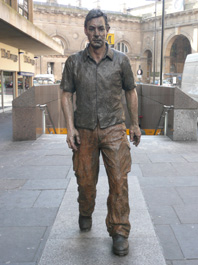About Walkhappy
Walkhappy was just a name for this site, more or less plucked out of the blue when the first name I thought of had already been registered. It didn't mean anything to start with, but as an enthusiastic walker it has become something of a mantra for me and I'm using it here as a place to reflect on some of the things that are so positive about walking.
 |
| Man With Potential Selves. Painted bronze by Sean Henry - Newcastle. credits |
If you are lucky enough to have a working pair of legs and can use them to get around you probably think that's all there is to it. The point is you may be able to mechanically use your legs but I think you can get more out of the trip if you become more conscious of what you are doing. When I worked sitting at a computer all day I would spend some of my lunch hour walking whenever I could. I needed to move, to stride out, to breath (even if it was tinged with hydrocarbons and Nitric Oxide). I found it was particularly good to use that time to become more aware of my body in a kind of meditation. It was "grounding" meaning that it helped to bring me back to the real world after focussing on a screen for hours. I still do this when I am unhurried, maybe walking in the park or on walk to the shops.
Tai Chi is sometimes called a moving meditation and in Aikido it is important develop an unbroken concentration throughout the execution of a technique: a "unity of calm and action"[1]. The Zazen meditation of Zen Buddhists is often translated as "Just Sitting", so I think of this as "Just Walking" - the same principle put into an everyday context. It is not about getting to your destination it is about an awareness of the walking itself.
Just Walking
I work through a scheme something like this: walking at your normal pace, first become aware of the ground under your feet, feel the contact on each step. How does the ground feel - is it smooth, is it rough, are there obstacles? How do the legs feel - is your gait relaxed or stiff? Are you walking fast to get somewhere or are you ambling slowly? Check out your posture - straighten up, walk taller, but relax. Feel as though you are suspended by a string attached to the crown of your head. Relax your shoulders, roll them back and down - don't force them. Relax and open the chest, get a feeling of expansion and openness in the heart area. Be aware of your mental and emotional state - if you are stressed in some way try not to give that state any more energy; as you relax your body it may induce the mind to relax as well so that the anxiety may change and dissipate as you walk. Feel your "centre", that point an inch or two below the navel, how is it moving? It might be helpful to feel as through your centre is moving along a rope in the direction of travel. Check your whole posture again - if you are still tense, let it go. Just be aware of the whole process of walking - your arms swinging slightly your legs relaxed but working, feeling how your feet are touching the ground. What is your face doing? Relax it - be happy that you can enjoy this moment on the planet. Be aware of your whole body in its locomotive activity and extend your awareness to your environment. Aim to maintain that awareness for a time. If you lose it, just start again, try not to get cross with yourself. The idea is to to develop an unbroken stream of mindful awareness. Learn to "let go of your worries and your sorrows in this space" - this is the "secret of walking meditation"[2]. Walkhappy.
 |
| Walking. credits |
Most of us are not monks, but we don't need to wait for a formal situation. Life is too short - for most of us it has to be a case of taking the opportunity and "just doing it". I find I can get a lot out of the practice by walking at a normal pace. Of course conditions are not always ideal for this practice - there may be wind and rain to battle against or you may be carrying shopping bags or a heavy rucksack on your back. I really only try to do Just Walking when the conditions are conducive. However, I do think that some of the experience rubs off on the way you walk most of the time. Even on a poor day maybe I just dip in to pay attention to my posture and state of mind momentarily, and even that can be beneficial.
If you do try Just Walking you will probably find that you start to take more notice how other people are walking. How is their gait - do they look relaxed or tense, are they balanced? What does their posture say about them? What is their expression? Are they aware? Don't be critical, maybe they have an injury or maybe they have problems on their mind - just notice. Maybe it will inform your own practice.
References
[1] Koichi Tohei. Aikido in Daily Life (1966) (Rikugei publishing house, Tokyo. ISBN 0-87040-221-8).
[2] Thich Nhat Hanh. A Guide to Walking Meditation. (1985) (Fellowship publications New York. )
Translated by Jenny Hoang and Nguyen Anh Huong, Edited by Robert Aitken and Joseph Bobrow.
[3] Kamalashila. Meditation. The buddhist way of tranquility and insight. (1992) Windhorse Publications (ISBN 0-904766-56 X).
[4] Thich Nhat Hanh. Being Peace. (1992) (Rider London. ISBN 0-7126-5412-7 ).